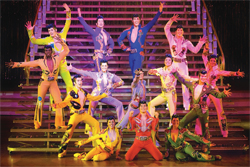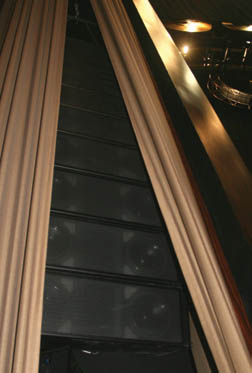
Both the main and monitor consoles are similar LCS Cue Console control surfaces, each comprised of four 16-fader bays, three meter modules, and a transport module.
They’re built into custom studio console furniture by Sound Construction & Supply of Nashville.
In the control room, redundant main and backup 48-channel Ableton Mac computers, each equipped with RME MADI cards feeding dual Optocore MADI interfaces, are used in the show for Elvis’ voice, time code, click track, additional band tracks, and replacement tracks if a musician is missing due to illness or otherwise.
Each musician has so much choreography that understudy musicians are unpractical.
In the main equipment room backstage, a Steinberg Nuendo 128-track Mac computer, using two 64-channel RME MADI cards going to a third Optocore dual MADI interface, provides playback routed to the show’s input channels. The set-up allows sound checks and rehearsals without musicians.
“We do this with a file change in Optocore to move the inputs from the normal stage boxes and RF inputs to inputs from the Nuendo system,” Beck explains.
“No wires to re-patch or switches – just a different Optocore file with a different audio input map to get 128 tracks of playback where live inputs would be.”
The main console employs two TC Electronic M6000 reverbs for effects, one set up as four machines for drums, percussion, guitars and horns, and the other for Elvis vocal tracks, live lead vocals and backing vocals. The monitor mixer uses eight TC M-One reverbs, four for vocals and four for instruments.
All Shook Up
The main sound reinforcement system consists of left and right 12-box Meyer MICA compact line arrays, flown above four deck-stacked 700-HP subwoofers.
Two more 12-box MICA center cluster arrays are supplemented by eight flown M3D directional subs.
Across the front of the 80-foot wide stage, nine M1-SM cabinets are hidden behind soffits in the stage lip, with four Meyer M’elodie compact line array modules and a pair of UPJunior compact loudspeakers filling in at the sides.
Extensive coverage by the surround system is accomplished by four pairs of Meyer MSL-4, UPQ and UPJ on each side of the theater to cover far, mid and near seats from oblong coves in the theater’s side walls.
Overhead there are three rings of down fill loudspeakers, with five MTS-4A loudspeakers from the first and highest catwalk, five CQ-1s across the second catwalk and five UPJs from the third and lowest catwalk.
Yoked UPJ and single M’elodie cabinets provide rear-fill surrounds from the balcony rail, and additional rear surround comes from UPA-1Ps at the back of the theater.
All 144 loudspeakers are controlled and monitored via Meyer RMS (remote monitoring systems) on two screens, one for the mains and a second for the surrounds.
The main LCS system also employs a 24-channel LCS Wild Tracks playback system to use with the extensive surround system.
One unusual and effective feature in the sound design is 20 Crown Audio MA-3600-powered Danley Sound Labs TH-115 tapped-horn subwoofers, which are installed in 5-foot deep concrete bunkers throughout the theater’s floor and covered with plywood. A Waves BassMaxx processor is used on these subs to great effect at several points in the show.
Optocore provides the digital backbone in the form of the largest single-ring fiber optic digital audio network ever installed. The audio network consists of 504 inputs and 776 outputs. Elvis’ Optocore system has 21 network devices on a single synchronous, redundant optical ring.


